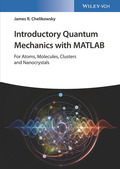Introductory Quantum Mechanics with MATLAB
For Atoms, Molecules, Clusters, and Nanocrystals

1. Auflage November 2018
224 Seiten, Softcover
2 Abbildungen
Lehrbuch
Kurzbeschreibung
Filling the need for an accessible approach to the concepts of quantum theory, this book uses MATLAB codes to allow readers to experiment with the numerical techniques described. Unique coverage of such hot topics as clusters, nanocrystals, transitions and organic molecules.
Jetzt kaufen
Preis: 83,90 €
Preis inkl. MwSt, zzgl. Versand
Euro-Preise für Wiley-VCH- und Ernst & Sohn-Titel sind nur für Deutschland gültig. In EU-Ländern gilt die lokale Mehrwertsteuer. Portokosten werden berechnet.
Der überaus erfahrene Autor füllt mit diesem Lehrbuch eine Lücke. Die Konzepte der Quantentheorie werden zugänglich und praxisorientiert präsentiert. Durch MATLAB-Codes lassen sich die beschriebenen numerischen Verfahren einfach umsetzen.
Hochaktuelle Themen, wie Cluster, Nanokristalle, Übergänge und organische Moleküle, werden umfassend abgedeckt. DFT, Variation und verschiedene andere Methoden sowie Annäherungswellenfunktionen werden ebenfalls erläutert.
1 Introduction to quantum theory
2 One electron atoms
2.1 The Bohr atom
2.2 The Schrödinger equation
2.3 The electronic structure of atoms and the periodic table
3 Multi-electron systems: atoms and molecules
3.1 The variational principle
3.2 The Hartree approximation
3.3 The Hartree-Fock approximation
4 The electron gas
4.1 The free electron model
4.2 The Thomas-Fermi approximation
4.2 Exchange interactions
5 Density functional theory
5.1 The Hohenberg-Kohn-Sham Theory
5.2 The Kohn-Sham equation
6 Pseudopotential theory
Part 2 Numerical Methods
7 Methods for atoms
7.1 Variational methods
7.2 Integration methods
8 Methods for molecules and clusters
8.1 Basis set methods
8.2 Grid methods
8.3 Diagonalization methods
8.4 Filtering methods
9 MATLABR codes for atoms and molecules
Part 3 Applications
10 Atoms
10.1 Energy levels and orbitals
10.2 Ionization and affinity energies
10.3 Polarizabilities
11 Diatomic and Simple Molecues
11.1 Chemical trends and ionicity
11.2 Energy levels and orbitals
11.3 Binding energies and vibrational modes
12 Clusters
12.1 Special form of matter
12.2 The structure of clusters
12.2 Role of quantum confinement
12.2 Energy levels and orbitals
12.3 Binding energies and vibrational modes
Appendix
A Units
B Matlab codes
Bibliography


